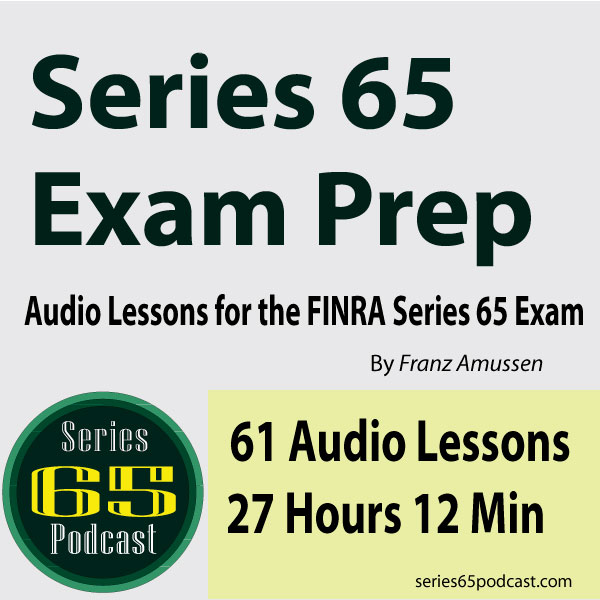Series 65 Exam Lesson 56 Securities Exchange Act of 1934 Quiz
This is a Series 65 Exam Lesson 56 Securities Exchange Act of 1934 Quiz: a free quiz for Series 65 Exam Lesson 56 Securities Exchange Act of 1934 Quiz. Try it and see how you do if you need help listen the lesson over.
Series 65 Exam Lesson 56 Securities Exchange Act of 1934 Quiz
Series 65 Exam Lesson 56 Securities Exchange Act of 1934 Quiz is covering the Annuities information you need to understand for the Series 65 Exam
Below are questions based on Series 65 Exam Lesson 56 Securities Act of 1933 lesson of the series. Choose the letter of the correct answer.
Series 65 Exam Lesson 56 Securities Exchange Act of 1934 Quiz
1. Which of the following is true about the Securities Exchange Act of 1934?
(Select all that apply.)
A. It applies to exempt securities.
B. It determines what fair trading practices are.
C. It regulates the secondary trading of securities.
D. It was established by the Securities and Exchange Commission.
2. Which of the following is contained in a 10-K? (Select all that apply.)
A. balance sheet
B. cash flow statement
C. compensation of officers
D. income statement
3. The 10-Q is an audited financial report submitted quarterly to the Securities and Exchange Commission.
A. True
B. False
4. A ___ is filed if the company changes its name or there’s a 5% or greater change in the number of shares outstanding.
A. 10-C
B. 13-G
C. 15-B
D. 8-K
5. Which of the following is required from the broker-dealers by the Securities Exchange Act of 1934?
(Select all that apply.)
A. buy back stocks for customers that reneged on their transactions
B. electronically deliver clients’ confirmation and statements
C. maintain a minimum net capital
D. send customers a copy of their income statement
6. Under ___, margins are regulated from brokers to their customers.
A. Regulation D
B. Regulation M
C. Regulation T
D. Regulation U
7. Broker-dealers are allowed to disclose to customers the routing of the customers’ orders.
A. True
B. False
8. It is a totally anonymous matching of buy and sell orders.
A. alternative trading system
B. electronic exchange
C. electronics communication network
D. physical exchange
9. Which of the following are/were physical exchanges?
(Select all that apply.)
A. Cincinnati Stock Exchange
B. New York Stock Exchange (NYSE)
C. Pacific Stock Exchange
D. Philadelphia Stock Exchange
10. Which of the following is true about penny stocks?
(Select all that apply.)
A. They are sold on the over-the-counter bulletin board.
B. They are unsolicited orders.
C. They are traded on the NASDAQ and other listed exchanges.
D. They sell at less than $5.
11. The broker is not required to assess a penny stock buyer’s financial situation if the buyer is a/an ___.
(Select all that apply.)
A. accredited investor
B. client whose order is unsolicited
C. insider
D. interstate citizen
12. It is trading on nonpublic material information on the company.
A. front running
B. insider trading
C. pegging
D. wash trade
13. This is the catchall rule that prohibits anything fraud even if it is not specifically prohibited in the Securities Exchange Act of 1934.
A. Rule 10b-5
B. Rule 127-c
C. Rule 144A
D. Rule 145
14. For unlawful practices under the Securities Exchange Act of 1934, suits can be brought within ___ of discovery.
A. six months
B. one year
C. two years
D. three years
15. If a control person owns a position of a stock and he wants to lock in his profit or loss, he can ___.
A. dribble out
B. peg the stock
C. short against the box
D. short sell the stock
16. Anybody that has nonpublic material information on the company is considered an insider.
A. True
B. False
17. In the United Sates, they are exempted from the rules that prohibit insider trading.
(Select all that apply.)
A. congressmen
B. directors of the company
C. officers of the company
D. senators
18. Insiders can trade on the material nonpublic information once the information has been made public.
A. True
B. False
19. Only the Securities and Exchange Commission can sue insider traders.
A. True
B. False
20. The statute of limitation for insider trading is ___.
A. one year
B. three years
C. five years
D. ten years
We hope you did well on this Quiz
Series 65 vs Series 66 Exam
The Series 65 exam is designed for those who do not have a Series 7 license. The content of both exams are similar though the Series 65 will be more heavily concentrated on Investment products and economics (like you would need to learn for the SIE and Series 7 Exam). … The Series 66 exam has a little more State law (such as what you will find in the Series 63 Exam) and some esoteric investment products.
Our audio lessons for both the Series 65 and Series 66 cover the material you would need to learn for the SIE and Series 7 exam so it may be a little more than you need for the Series 66 but we want you to be fully prepared!
The only difference between the two series of exam lessons (the 65 and 66) is that the Series 66 exam also covers the material needed for the Series 63 exam.
Our other website s for FINRA and other certification Exams include:
https://www.series7podcast.com
https://www.series7podcast.com
https://insuranceexampodcast.com
https://insuranceexampodcast.com
https://www.reexampodcast.com/
Podcast: Play in new window | Download


